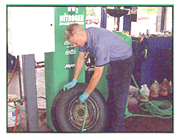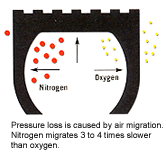
You may have heard about the “latest trend” to use nitrogen instead of compressed air in vehicle tires. However, there’s nothing new about nitrogen inflation of tires. It’s been around since Texan Dr. Larry Sperberg brought it to our attention in 1968. That’s when he pronounced that a tire wears out from the inside out – a process he called “chemical degradation.”
While not dismissing the other benefits of using nitrogen instead of air, Sperberg focused on the negative impact of moisture introduced into a tire via undrained compressor tanks.
“This moisture-laden air (oxygen catalyzed by water) works its way into and through the tire cord body, causing heat, expansion, and loss of strength and elasticity,” he said.
“Such air also attacks the wheel, ultimately penetrating the paint and oxidizing the iron below it to form iron oxide or rust. Even aluminum is not immune from rusting, forming aluminum hydroxide that produces an extremely fine dust,” said Sperberg.
Although the good doctor’s ideas were deemed “interesting” nearly 40 years ago, they didn’t make it to the top of the pile. Sperberg kept pushing, issuing studies in the 1980s and 1990s that kept the matter alive, but with nominal success.
But more recent developments – primarily soaring fuel prices and tire safety concerns – did what Sperberg’s raw science could not. Nitrogen inflation is now the HOT topic in the tire industry.
Carrying promises of longer tire life, better fuel mileage, improved road handling, better inflation pressure maintenance, elimination of oxidation and rust, and improved truck tire retreadability – not to mention increased revenue – nitrogen generating/dispensing equipment have become a HOT products in the industry.
Nitrogen Science 101
To understand the basis for the sudden interest in nitrogen, a little background is in order.
A dry, inert gas, nitrogen’s main benefit is its molecular structure; nitrogen molecules are considerably larger than oxygen molecules, so they don’t permeate a tire nearly as quickly. Oxygen can pass through an innerliner, belt package and sidewall/tread three to four times faster than nitrogen.
This factor helps maintain proper inflation pressure longer, which means tires run cooler, thereby increasing safety and reducing operating cost. That’s the basic science behind nitrogen and the many marketing claims being made.
As Sperberg noted, replacing moisture-friendly oxygen with naturally dry nitrogen means oxidation of tire and wheel components is virtually eliminated. And, without water vapor and oxygen to heat things up, nitrogen-inflated tires supposedly run cooler, last longer and deliver a host of other benefits.
Science and Stats
Even though the idea of nitrogen inflation has been around for a while, it seems that suppliers and tiremakers are just starting to get their arms around its varied benefits. Some of what nitrogen provides is based on science. Some is based on statistics. And the rest is, well, somewhat interpretive.
 Many experts say that the effects of underinflation of tires cost this country two million gallons of gasoline a day. In fact, 90% of the tire failures on the road today are caused by underinflation.
Many experts say that the effects of underinflation of tires cost this country two million gallons of gasoline a day. In fact, 90% of the tire failures on the road today are caused by underinflation.
One company which makes nitrogen generators, said that an improvement of just 5% in tire life means at least 10 million fewer tires to dispose of in landfills per year.
When it comes to tire life, some industry observes say that a tire that is underinflated by 10% will lose approximately 7% of its service life.
Benefits
So you see, with nitrogen, proper inflation pressure is maintained for a much longer period of time. And, the nearly forgotten spare tire, inflated with nitrogen, will better retain its pressure for an emergency situation.
However, that doesn’t mean the end of routine inflation pressure checks. Nitrogen generator manufacturers and tiremakers alike continue to stress the importance of ongoing inflation checks. Nitrogen eventually leaks out, too, but that isn’t talked about very much.
Then, there are the extrapolated secondary benefits. Properly inflated tires, those filled with nitrogen, will not only help save fuel but will corner better on wet or icy roads.
A properly inflated tire, regardless of the gas inside of it, maintains the correct footprint on the road, which minimizes squirm and rapid tire wear and drivers get better fuel mileage because a properly inflated tire has less rolling resistance than an underinflated one – which also decreases auto emissions.
Another major point being made by nitrogen generator makers harkens back to Sperberg’s “chemical degradation.” According to at least one study, if the rate at which air permeates through the tire composite is slowed, so too is the rate of chemical aging.
Regardless of the claims, nitrogen is climbing the charts. Some industry experts say that, within three to six months, there will be a nationwide change in the way nitrogen inflation is being provided and used. Since the use of nitrogen is the standard in other parts of the world – some believe it should also be here.
Surprising Start
Oddly, the nitrogen movement really caught fire among passenger car drivers, not major trucking firms, a fact that has puzzled the makers of nitrogen generators.
In the trucking industry, which struggles with tires that can lose 2 psi per month, even nitrogen’s most basic benefit should be big news. Despite years of pitching, however, nitrogen has made minimal inroads with over-the-road fleets. Today’s soaring diesel prices, and nitrogen’s other benefits, may be turning the tide.
Filling a truck tire with nitrogen will extend tire life by up to 25%, according to one equipment manufacturer. So, a truck tire that normally lasts 270,000 when filled with air, will last 337,500 miles if filled with nitrogen. That breaks out to big savings, too. At a savings of $120 per tire, a fleet of 50 trucks and 900 wheel positions would save more than $100,000 in tire costs by inflating with nitrogen.
There is the matter of inflation pressure checks. Do truck tires filled with nitrogen still require daily/weekly inflation checks? Some say no and have computed the savings in time and labor to be as much as $31,000 per year.
Others insist yes, pointing to the negative impact of even minimal pressure leakage. The subject will, no doubt, remain open for discussion.
From a safety and tire-life standpoint, most of the benefit talk focuses on heat. Science says that a tire filled with naturally dry nitrogen will run cooler than a tire filled with moisture-laden compressed air.
For the consumer contemplating a long summer vacation drive, properly inflated and cooler running tires would reduce the chance of a tire failure, a point some dealers have made in promoting nitrogen inflation.
For line-haul fleet owners, who hunt down cost-per-mile savings like heat-seeking missiles, such science should add up to monumental savings – numbers that are simply too large to ignore. What could be better than a longer-lasting truck tire that provides a more retreadable casing?
Getting Nitro ROI
A number of companies are producing and/or marketing nitrogen generators. They say they are filling orders as fast as they can, and, in many cases, are already backordered.
Nitrogen generators, as the name implies, produce nearly pure nitrogen. Using a membrane and filters, they also remove oxygen and pollutants, such as water and oil vapor, from inside a tire.
Nitrogen generators cost around $5,000, plus options, which can include a holding tank and maintenance fees for filter replacements every one or two years and a carbon element every two to three years. The heart of the generator, the membrane, lasts from 15 to 20 years, so that’s not really a cost factor.
Nitrogen in the Pits
The key reason pro race teams use nitrogen is convenience. In tank form, nitrogen is portable and can easily be moved from garages to pit areas. Because it’s moisture free, nitrogen is easy on expensive air tools. And, because it is non-flammable, unlike pure oxygen, nitrogen is safe to use. In terms of race performance, cooler-running tires help stretch out pit stops and provide a more consistent footprint.
Just how much a daily commuter will benefit from a cooler-running and subsequently longer-lasting tire is up for grabs, though.
Although the claims being made for nitrogen are effectively true, the real reward for a passenger tire user will vary a bit, say some. It’s a bit like people who take vitamin pills – some notice a definite difference, while others don’t notice anything, even though the vitamins are working their magic.
Tiremakers, once soft on nitrogen, have taken notice. Michelin okays the use of nitrogen in its passenger tire line. Strong support also comes from Bridgestone/Firestone for its commercial tires, and in June 2004, a technical bulletin was released from Goodyear approving the process.


